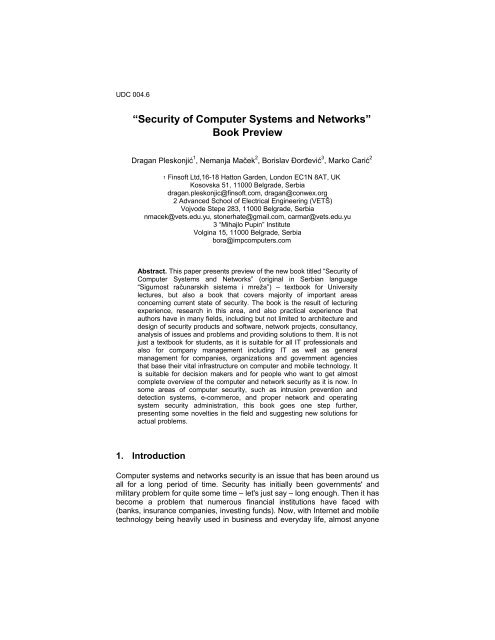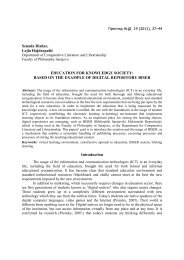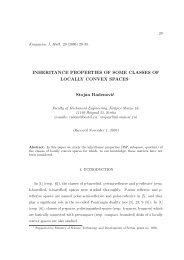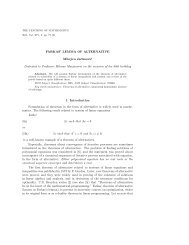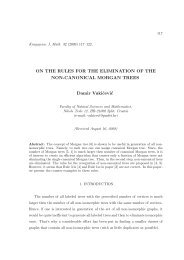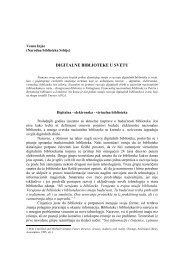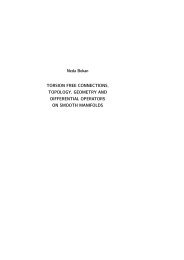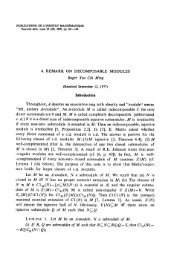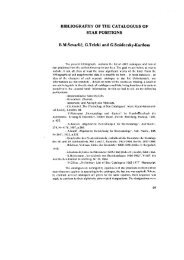“Security of Computer Systems and Networks” Book Preview
“Security of Computer Systems and Networks” Book Preview
“Security of Computer Systems and Networks” Book Preview
Create successful ePaper yourself
Turn your PDF publications into a flip-book with our unique Google optimized e-Paper software.
UDC 004.6<br />
<strong>“Security</strong> <strong>of</strong> <strong>Computer</strong> <strong>Systems</strong> <strong>and</strong> <strong>Networks”</strong><br />
<strong>Book</strong> <strong>Preview</strong><br />
Dragan Pleskonjić 1 , Nemanja Maček 2 , Borislav Đorđević 3 , Marko Carić 2<br />
1 Fins<strong>of</strong>t Ltd,16-18 Hatton Garden, London EC1N 8AT, UK<br />
Kosovska 51, 11000 Belgrade, Serbia<br />
dragan.pleskonjic@fins<strong>of</strong>t.com, dragan@conwex.org<br />
2 Advanced School <strong>of</strong> Electrical Engineering (VETŠ)<br />
Vojvode Stepe 283, 11000 Belgrade, Serbia<br />
nmacek@vets.edu.yu, stonerhate@gmail.com, carmar@vets.edu.yu<br />
3 “Mihajlo Pupin” Institute<br />
Volgina 15, 11000 Belgrade, Serbia<br />
bora@impcomputers.com<br />
Abstract. This paper presents preview <strong>of</strong> the new book titled <strong>“Security</strong> <strong>of</strong><br />
<strong>Computer</strong> <strong>Systems</strong> <strong>and</strong> <strong>Networks”</strong> (original in Serbian language<br />
“Sigurnost računarskih sistema i mreža”) – textbook for University<br />
lectures, but also a book that covers majority <strong>of</strong> important areas<br />
concerning current state <strong>of</strong> security. The book is the result <strong>of</strong> lecturing<br />
experience, research in this area, <strong>and</strong> also practical experience that<br />
authors have in many fields, including but not limited to architecture <strong>and</strong><br />
design <strong>of</strong> security products <strong>and</strong> s<strong>of</strong>tware, network projects, consultancy,<br />
analysis <strong>of</strong> issues <strong>and</strong> problems <strong>and</strong> providing solutions to them. It is not<br />
just a textbook for students, as it is suitable for all IT pr<strong>of</strong>essionals <strong>and</strong><br />
also for company management including IT as well as general<br />
management for companies, organizations <strong>and</strong> government agencies<br />
that base their vital infrastructure on computer <strong>and</strong> mobile technology. It<br />
is suitable for decision makers <strong>and</strong> for people who want to get almost<br />
complete overview <strong>of</strong> the computer <strong>and</strong> network security as it is now. In<br />
some areas <strong>of</strong> computer security, such as intrusion prevention <strong>and</strong><br />
detection systems, e-commerce, <strong>and</strong> proper network <strong>and</strong> operating<br />
system security administration, this book goes one step further,<br />
presenting some novelties in the field <strong>and</strong> suggesting new solutions for<br />
actual problems.<br />
1. Introduction<br />
<strong>Computer</strong> systems <strong>and</strong> networks security is an issue that has been around us<br />
all for a long period <strong>of</strong> time. Security has initially been governments' <strong>and</strong><br />
military problem for quite some time – let's just say – long enough. Then it has<br />
become a problem that numerous financial institutions have faced with<br />
(banks, insurance companies, investing funds). Now, with Internet <strong>and</strong> mobile<br />
technology being heavily used in business <strong>and</strong> everyday life, almost anyone
Dragan Pleskonjic, Nemanja Maček, Borislav Djordjević <strong>and</strong> Marko Carić<br />
who uses a computer <strong>and</strong> Internet cuts the deal with security in one way or<br />
another. For example, an individual that just wants to shop something on e-<br />
Bay heavily relies on security issues. Although this is as a very simple<br />
example which appears so easy to solve, it actually covers many aspects <strong>of</strong><br />
computer security <strong>and</strong> requires a lot <strong>of</strong> math, sweat, hard work <strong>and</strong> proper<br />
planning.<br />
Students at colleges <strong>and</strong> universities, IT pr<strong>of</strong>essionals, s<strong>of</strong>tware architects,<br />
developers, network <strong>and</strong> security administrators <strong>and</strong> many others are<br />
required to be quite familiar with security, privacy, protection <strong>and</strong> similar<br />
topics <strong>and</strong> issues.<br />
This is also important area for senior company management <strong>and</strong> decision<br />
makers as security in different area, including protecting vital infrastructure is<br />
“sine qua non” for today’s companies <strong>and</strong> organizations.<br />
2. Motivation, Goals <strong>and</strong> Who Should Read this <strong>Book</strong><br />
This book is based on lectures that are presented to students on “<strong>Computer</strong><br />
Networks Security” in many years <strong>and</strong> on different schools <strong>and</strong> universities. It<br />
also covers experience gained through practical work in the field. This<br />
includes architecture <strong>and</strong> design <strong>of</strong> computer networks, complex s<strong>of</strong>tware<br />
projects <strong>and</strong> information systems, network security administration as well as<br />
research done in particular areas <strong>of</strong> computer systems <strong>and</strong> information<br />
security.<br />
This book serves the protectors – the persons who are willing to give their<br />
best shot to protect their assets 24/7. Note that hackers have all the time in<br />
the world to wait, <strong>and</strong> yes, they will catch you while you take a nap <strong>and</strong> get<br />
what they want – be it the money, the data or revenge. It reveals the threats,<br />
the attacks <strong>and</strong> dangers you will be exposed to on the Internet, as well as the<br />
methods, techniques, tools, procedures <strong>and</strong> products that can help you to<br />
establish a bit more secure network or computer system. The book is suitable<br />
for both beginners, medium <strong>and</strong> high level users, programmers,<br />
administrators, designers <strong>and</strong> other pr<strong>of</strong>essionals that interoperate with<br />
security in one way or another. It is a textbook both for students that attend<br />
this course on their colleges <strong>and</strong> for management <strong>of</strong> companies that rely on<br />
computer systems <strong>and</strong> networks. It explains both the theory <strong>and</strong> the practice<br />
– one step at a time without taking detours to details we found unnecessary.<br />
This book will not teach you how to break into someone's network, or decrypt<br />
your neighbor's e-mail, but it will teach you how to make your network more<br />
secure <strong>and</strong> protect your e-mail's confidentiality <strong>and</strong> integrity.<br />
3. <strong>Book</strong> Scope <strong>and</strong> Content<br />
The first problem that authors have faced with is how to present this material<br />
to readers, having in mind that many areas are closely linked <strong>and</strong> overlapped,<br />
78<br />
ComSIS Vol. 4, No. 1, June 2007
ComSIS Vol. 4, No. 1, June 2007<br />
Security <strong>of</strong> <strong>Computer</strong> <strong>Systems</strong> <strong>and</strong> Networks<br />
<strong>and</strong> also having in mind necessary preconditions <strong>and</strong> knowledge required for<br />
active following <strong>and</strong> underst<strong>and</strong>ing <strong>of</strong> subjects that we are talking about. We<br />
identified that knowledge <strong>of</strong> mathematics, computer architectures, operating<br />
systems, computer networks <strong>and</strong> communications (including good knowledge<br />
<strong>of</strong> st<strong>and</strong>ard protocols <strong>and</strong> protocol stacks), data models <strong>and</strong> structures,<br />
databases, programming (especially system level programming, C, C++, C#<br />
<strong>and</strong> Java languages), <strong>and</strong> Internet is necessary. Also, many particular areas<br />
from above list <strong>and</strong> some additional are recommended knowledge to<br />
successfully follow book content<br />
In this situation, we took decision to briefly cover some areas at the<br />
beginning <strong>of</strong> book chapters <strong>and</strong> to remind readers before going into depth <strong>of</strong><br />
security elaboration.<br />
Another challenge was that this book, even highly technical has to deal<br />
with some areas that are not technical. Security is not just math <strong>and</strong><br />
technology. It depends a lot on psychological <strong>and</strong> social aspects (simply said<br />
– on people <strong>and</strong> their weaknesses), organizational, management, social<br />
sciences, legal <strong>and</strong> economic issues <strong>and</strong> also on organizations <strong>and</strong> policies.<br />
These makes book truly multidisciplinary <strong>and</strong> requires wider knowledge <strong>of</strong><br />
many different areas.<br />
3.1. Chapters <strong>and</strong> appendices<br />
<strong>Book</strong> contains 16 chapters <strong>and</strong> 5 appendices arranged in a manner we find<br />
suitable for students, beginners, but also advanced users, system<br />
administrators, s<strong>of</strong>tware developers <strong>and</strong> IT <strong>and</strong> company management.<br />
Chapter 1: Threats, attacks, security <strong>and</strong> methods <strong>of</strong> protection. This<br />
chapter covers the basics <strong>of</strong> computer system <strong>and</strong> network security: security<br />
attacks <strong>and</strong> threats, mechanisms <strong>and</strong> services, security as an evolving<br />
process <strong>and</strong> the C.I.A. (confidentiality-integrity-availability) triad. This chapter<br />
also covers threat modeling, risk equation, security strategies (like layers <strong>of</strong><br />
protection) <strong>and</strong> two basic security models (secured channel <strong>and</strong><br />
gatekeeper/ACL based model) <strong>and</strong> deals with the information classification.<br />
This chapter is introduction to almost anything you will find in latter chapters.<br />
For example, it is a normal path for a reader to underst<strong>and</strong> what modification<br />
attack is first <strong>and</strong> then to read more on session hijacks as well as it is<br />
necessary to underst<strong>and</strong> what secure channel is if you are about to read<br />
more on cryptographic protocols.<br />
Chapter 2: Security architectures <strong>and</strong> models. This chapter covers some<br />
basics regarding security architectures – abstraction, information hiding,<br />
protection rings, security labels, modes <strong>of</strong> operation <strong>and</strong> distributed<br />
architectures, as well as architecture vulnerabilities (covert channel, lack <strong>of</strong><br />
perimeter checking, maintenance hook vulnerability <strong>and</strong> TOC/TOU attack),<br />
<strong>and</strong> recovery procedures. Aside from that, this chapter deals with the<br />
evaluation criteria (TCSEC <strong>and</strong> ITSEC), accreditation, <strong>and</strong> certification<br />
79
Dragan Pleskonjic, Nemanja Maček, Borislav Djordjević <strong>and</strong> Marko Carić<br />
(DITSCAP <strong>and</strong> NIACAP). At the beginning <strong>of</strong> the second part <strong>of</strong> this chapter<br />
we have tried to resolve the problem which is common for many authors <strong>and</strong><br />
publishers: we've tried to explain the difference between terms Safety <strong>and</strong><br />
Security. The second part <strong>of</strong> the chapter requires some basic knowledge <strong>of</strong><br />
formal theories as it deals with the different information security models –<br />
access control models (Bell-LaPadula, access matrix <strong>and</strong> take-grant model),<br />
integrity models (Biba <strong>and</strong> Clark-Wilson) <strong>and</strong> information flow models (noninterference<br />
model <strong>and</strong> composition theories).<br />
Chapter 3: Cryptography. Although there are many different ways to<br />
improve security, cryptography still has a major role in the world <strong>of</strong> information<br />
protection. Therefore, this chapter is dedicated to a short review <strong>of</strong> useful<br />
cryptographic accomplishments. At the beginning <strong>of</strong> the chapter, we've<br />
managed to put up together a subset <strong>of</strong> mathematical facts <strong>and</strong> theorems<br />
which are necessary for a reader to underst<strong>and</strong> the processes <strong>of</strong> encryption,<br />
signing <strong>and</strong> calculating hash. Like many other books on cryptography, this<br />
book also contains a short history <strong>of</strong> encryption, a process which has, thanks<br />
to cryptoanalysis, been forced to advance from simple origins to very complex<br />
algorithms. This book covers most modern symmetric (DES, AES, IDEA <strong>and</strong><br />
all AES finalists) <strong>and</strong> public key encryption algorithms (RSA <strong>and</strong> ElGammal),<br />
stream ciphers (RC4 for example), hash functions (MD5 <strong>and</strong> SHA),<br />
pseudor<strong>and</strong>om number generators, as well as digital signatures, certificates<br />
<strong>and</strong> public key infrastructure. At the end <strong>of</strong> this chapter, we've given some<br />
pointers to readers that wish to use cryptography in their business or<br />
everyday life, as many s<strong>of</strong>tware products provide a user with ability to use<br />
complex algorithms with the aid <strong>of</strong> a simple interface, without a need to know<br />
details <strong>of</strong> algorithms <strong>and</strong> the way that they are implemented.<br />
Chapter 4: Cryptographic <strong>and</strong> authentication protocols. This chapter is a<br />
rather easy reading, but also a logical successor to 120 pages <strong>of</strong><br />
cryptographic algorithms <strong>and</strong> problems (which readers that lack knowledge <strong>of</strong><br />
maths usually try to avoid). Therefore, cryptography by itself is removed as<br />
much as it was possible from this chapter, leaving only some basics <strong>and</strong><br />
protocols. We can call it <strong>“Security</strong> protocols”. To simplify this, this chapter is<br />
suitable both for ones that are familiar with computer networks <strong>and</strong> for those<br />
who are familiar with cryptography but do not know how to set up their IP<br />
address. This chapter covers two crucial forms <strong>of</strong> security protocols:<br />
cryptographic protocols (SSL <strong>and</strong> IPSec working in transport <strong>and</strong> tunneling<br />
mode with both AH <strong>and</strong> ESP protocols as well as IKE key-exchange protocol<br />
explained in a rather simple way) <strong>and</strong> authentication protocols (Kerberos <strong>and</strong><br />
RADIUS). However, due to publisher's scope limitation, installation,<br />
configuration <strong>and</strong> administration <strong>of</strong> s<strong>of</strong>tware that implements these protocols<br />
is not described <strong>and</strong> analyzed in this chapter as it requires deep knowledge <strong>of</strong><br />
Linux operating system's networking services.<br />
Chapter 5: Firewalls. Unlike written in the book Firewalls 24/7, we've really<br />
tried to simplify firewalling to its very basics. We've managed to basically<br />
80<br />
ComSIS Vol. 4, No. 1, June 2007
ComSIS Vol. 4, No. 1, June 2007<br />
Security <strong>of</strong> <strong>Computer</strong> <strong>Systems</strong> <strong>and</strong> Networks<br />
cover all aspects <strong>of</strong> firewalling in theory <strong>and</strong> practice: packet filtering, NAT<br />
<strong>and</strong> proxies. This chapter will teach a reader how to install a firewall on a<br />
$100 computer using any Linux distribution that comes with a Netfilter <strong>and</strong><br />
iptables (for packet filtering <strong>and</strong> NAT) <strong>and</strong> Squid (for proxy). Port scanning is<br />
also explained <strong>and</strong> reader is introduced to how it really works through a<br />
couple <strong>of</strong> examples based on Nmap. Windows workstation users will find<br />
some useful information on freeware firewalls for Windows workstation<br />
computers <strong>and</strong> network administrators are introduced in a very simple way to<br />
packet filtering with Cisco routers. You will not find ISA or any other<br />
commercial enterprise firewall solutions reviewed here – please, feel free to<br />
use Linux with iptables <strong>and</strong> squid in order to achieve higher goals <strong>and</strong> have<br />
smaller expenses.<br />
Chapter 6: Intrusion detection <strong>and</strong> prevention systems. Firewalls <strong>and</strong><br />
cryptographic tunnels will protect your network from outsiders. But you still<br />
have a problem with semi-outsiders <strong>and</strong> insiders including their mutual<br />
collaboration. And with the hackers that will exploit any known vulnerability in<br />
your security configuration. So what shall you do? You set up an intrusion<br />
detection/prevention system (IDS/IPS) that sends alerts on suspicious<br />
activities that are invisible to firewalls. This chapter covers these systems –<br />
their basics <strong>and</strong> classification according to different criteria (what <strong>and</strong> where<br />
they do their job <strong>and</strong> how they detect intrusions) <strong>and</strong> the theory behind them<br />
(true/false positives/negatives, sensitivity, specificity, accuracy, ROC <strong>and</strong><br />
predictive values). Snort is briefly explained (its structure <strong>and</strong> configuration)<br />
as an open-source solution <strong>and</strong> the de-facto IDS st<strong>and</strong>ard. Aside from Snort,<br />
Fortego All-Seeing Eye is also briefly described as a very strict after-the fact<br />
Windows IDS that requires some initial training. This chapter introduces a<br />
new IDS system for wireless networks (WIDS) that has been developed by<br />
one <strong>of</strong> authors. The use <strong>of</strong> artificial intelligence in IDS/IPS systems is briefly<br />
discussed in this chapter <strong>and</strong> is, in parts, a novelty <strong>of</strong> authors.<br />
Chapter 7: Malicious s<strong>of</strong>tware. This chapter deals with s<strong>of</strong>tware that knows<br />
no strict <strong>and</strong> precise definitions – malicious s<strong>of</strong>tware (malware). Malware can<br />
be defined as any code that is written with intent to cause damage to<br />
computer (be it networked or not), or to make it hard or impossible for users<br />
to use that computer or to compromise data confidentiality. There are various<br />
forms <strong>of</strong> malware – some require carriers, others do not; some <strong>of</strong> them do<br />
replicate; others do not. This chapter covers almost any type <strong>of</strong> malware –<br />
worms, viruses, logic bombs, trojans, spyware <strong>and</strong> adware (the last one being<br />
usually nothing more than a user molester). Each type is defined <strong>and</strong> briefly<br />
elaborated. Readers are also introduced to specific malware (like MyDoom<br />
<strong>and</strong> Sasser worms) that have managed to cause major damage at their best<br />
<strong>and</strong> to free ways (free s<strong>of</strong>tware <strong>and</strong> precaution that should be considered) to<br />
protect their assets from malware. A special part <strong>of</strong> this chapter is dedicated<br />
to rootkits – a stealth threat that makes an attacker invisible <strong>and</strong> gives him the<br />
root privileges over a target computer. UNIX <strong>and</strong> Windows rootkits are<br />
81
Dragan Pleskonjic, Nemanja Maček, Borislav Djordjević <strong>and</strong> Marko Carić<br />
classified <strong>and</strong> analyzed in this chapter as well as the famous example <strong>of</strong><br />
unfair usage <strong>of</strong> rootkits it an edgy legal DRM matter.<br />
Chapter 8: E-commerce <strong>and</strong> Internet security. E-business is becoming a<br />
common form <strong>of</strong> business these days as it reduces costs <strong>and</strong> introduces new<br />
ways to starting, development <strong>and</strong> growth <strong>of</strong> business. But, the fact that the<br />
Internet is the e-business infrastructure <strong>of</strong> Internet introduces several new<br />
security risks <strong>and</strong> possibilities that the attackers can exploit. The criminal<br />
goes there where the money already is – in this case, to the Internet, where<br />
you can find it at its worst form. This chapter deals with the e-business<br />
security; we hope that it will inform readers <strong>of</strong> security risks that are related to<br />
e-commerce <strong>and</strong> to adequate protection methods <strong>and</strong> mechanisms. Aside<br />
from that, this chapter covers other aspects <strong>of</strong> Internet security – phishing,<br />
pharming, spam, VoIP <strong>and</strong> P2P network security.<br />
Chapter 9: Wireless <strong>and</strong> mobile networks security. The growth <strong>of</strong> wireless<br />
<strong>and</strong> mobile networks reminds us on growth <strong>of</strong> Internet in mid 90's. Simple<br />
implementation <strong>of</strong> devices, flexibility, reduced costs <strong>and</strong> a choice <strong>of</strong> different<br />
devices (wireless network cards <strong>and</strong> access points) from different vendors are<br />
several factors that support the growth. Due to their advantages, wireless<br />
networks are commonly used in many institutions, companies or other private<br />
or public organizations. Aside from that, there is also a trend <strong>of</strong> setting up hot<br />
spots on places where many people pass by – these hot spots will let anyone<br />
who uses a supported communication device to connect to the Internet. On<br />
the other h<strong>and</strong>, the use <strong>of</strong> wireless networks is usually followed by many<br />
problems regarding security <strong>and</strong> privacy. At its lowest layer – just check out<br />
how the antenna spreads the signal throughout the air. Can you really be so<br />
certain that no unauthorized users will catch that signal – can you precisely<br />
define the wireless network perimeter? No. This chapter deals with all <strong>of</strong><br />
security problems related to wireless <strong>and</strong> mobile networks – Wireless LAN<br />
security (WEP, 802.1x, EAP, WPA, <strong>and</strong> 802.11i, for example), GSM security<br />
<strong>and</strong> Bluetooth security. Major algorithms, st<strong>and</strong>ards, protocols, security<br />
procedures <strong>and</strong> testing tools are briefly described in a matter we find suitable<br />
for most readers.<br />
Chapter 10: Operating system security. Everything runs on a certain form<br />
<strong>of</strong> operating system. Running a perfectly safe application or service on an<br />
insecure operating system may give a fake sense <strong>of</strong> security but actually<br />
equals to disaster. Therefore, an administrator must make a host operating<br />
system as much secure as possible. This chapter is divided in three parts.<br />
The first part deals with the fundamental concepts <strong>of</strong> operating system<br />
security <strong>and</strong> protection (protection domains, access matrices, operating<br />
system security mechanisms, etc.). The second part deals with the Linux<br />
security (file system access control, user accounts, sudo, networking,<br />
s<strong>and</strong>boxing with chroot jail, syslog, etc.), but most <strong>of</strong> the principles <strong>and</strong><br />
techniques discussed here can be used with any UNIX based operating<br />
system. The third part discusses basics <strong>of</strong> Micros<strong>of</strong>t's Windows security (user<br />
82<br />
ComSIS Vol. 4, No. 1, June 2007
ComSIS Vol. 4, No. 1, June 2007<br />
Security <strong>of</strong> <strong>Computer</strong> <strong>Systems</strong> <strong>and</strong> Networks<br />
accounts, group policies, NTFS permissions, auditing, etc.) This chapter is<br />
suitable for almost everyone – ranging from a home user who wants to hide<br />
files from his little sister or parent who want to protect his kids, to a network<br />
administrator who wants to protect his shared resources <strong>and</strong> underst<strong>and</strong> what<br />
has been written to log files.<br />
Chapter 11: Database security. When we talk about information security, we<br />
think about secure transfer <strong>and</strong> secure storage <strong>of</strong> data. When we talk about<br />
secure storage, we mostly think <strong>of</strong> secured file systems (described in chapter<br />
3) <strong>and</strong> databases. This chapter deals with the various aspects <strong>of</strong> database<br />
security. Chapter begins with basic database security administration –<br />
permissions, roles, views <strong>and</strong> stored procedures. Despite the fact that<br />
database should normally reside behind the Web server <strong>and</strong> in private<br />
network (not in the DMZ), it's logical position in the network <strong>and</strong> firewall<br />
protection doesn't make it prone to malicious activities, like a well known SQL<br />
injection. We've used MS SQL Server to demonstrate that improperly<br />
protected database can be easily manipulated by an attacker that is familiar<br />
with SQL injection attacks.<br />
Chapter 12: Secure programming. S<strong>of</strong>tware development is a process that<br />
gives birth to many useful applications but also to numerous security flaws<br />
<strong>and</strong> vulnerabilities. Although some authors might agree that this chapter<br />
should reside somewhere on the beginning <strong>of</strong> the book, we have found that it<br />
fits right here – not all computer users are programmers; <strong>and</strong> if they even are<br />
familiar with programming, a chance that they will have access to closed<br />
source s<strong>of</strong>tware is very small. Therefore, we have decided to deal with the<br />
computer <strong>and</strong> network administration <strong>and</strong> engineering problems first, <strong>and</strong> with<br />
the designer's <strong>and</strong> programmer's issues later. This chapter deals with the<br />
fundamentals <strong>of</strong> secure programming – that is a writing a code <strong>and</strong> having<br />
security in mind. It covers the buffer overflow problem in C <strong>and</strong> C++ (a<br />
problem that can be exploited to inject malicious code into another application<br />
or service), the most important aspects <strong>of</strong> secure programming in Java <strong>and</strong><br />
methods <strong>of</strong> s<strong>of</strong>tware products protection (registration keys, keyfiles,<br />
authorization <strong>and</strong> dongles). This chapter also covers the advantages <strong>of</strong><br />
managed code <strong>and</strong> the new Security Development (SDL) lifecycle from<br />
Micros<strong>of</strong>t.<br />
Chapter 13: Network monitoring. Reliability <strong>and</strong> availability <strong>of</strong> computer<br />
systems <strong>and</strong> networks has become a critical aspect <strong>of</strong> many production sites<br />
these days <strong>and</strong> one <strong>of</strong> security goals, as well. Due to that, several protocols<br />
<strong>and</strong> complete sets <strong>of</strong> tools for network monitoring <strong>and</strong> management have<br />
been developed. This chapter covers basics <strong>of</strong> network monitoring <strong>and</strong><br />
management, without detouring into unnecessary details. SNMP protocol is<br />
briefly described, as well as the Nagios network monitoring system. No<br />
detailed instructions for this tool installation have been given, as we consider<br />
that readers that deal with network monitoring are usually familiar with<br />
s<strong>of</strong>tware installation <strong>and</strong> administration on Linux systems.<br />
83
Dragan Pleskonjic, Nemanja Maček, Borislav Djordjević <strong>and</strong> Marko Carić<br />
Chapter 14: Organizational, physical, legal <strong>and</strong> social aspects. Unlike<br />
other chapters, this one is focused on the topics that most “geeks” will<br />
definitely try to avoid. Those topics are based on management, sociology,<br />
psychology, organization, <strong>and</strong> law. Although many might disagree, this is<br />
equally important domain as cryptography <strong>and</strong> firewalling <strong>and</strong>, as such,<br />
should not be avoided. This chapter covers the basics <strong>of</strong> previously<br />
mentioned aspects – organizational, ethical <strong>and</strong> legal aspects in brief. Aside<br />
from that, biometrics <strong>and</strong> steganography are also briefly described. This<br />
chapter talks about intellectual property, authors’ rights <strong>and</strong> s<strong>of</strong>tware piracy<br />
<strong>and</strong> different approaches to these problems. Social aspect <strong>of</strong> security<br />
problems are also topic covered in this chapter.<br />
Chapter 15: Business continuity <strong>and</strong> disaster recovery planning. If the<br />
computer network is used as infrastructural basis <strong>of</strong> business information<br />
systems, you do not have any guaranties that everything will work perfectly<br />
<strong>and</strong> strictly according to plan. That means that you should be aware <strong>of</strong> the<br />
fact that incidents do happen <strong>and</strong> therefore you must prepare a plan to<br />
recover your business from occurring incidents. Incidents are not just minor<br />
security violations (like unauthorized access) which can easily be fixed, but<br />
also some fundamental dangers that can lead to cancellation <strong>of</strong> business.<br />
The business cancellation will last according to the quality <strong>of</strong> your business<br />
continuity <strong>and</strong> disaster recovery plans, which this chapter deals with. Unlike<br />
other domains <strong>of</strong> protection which are based upon reducing risk <strong>and</strong> setting<br />
up protection mechanisms, this domain h<strong>and</strong>les with the fact that the worst<br />
thing has already happened. Business continuity planning deals with the<br />
planning <strong>and</strong> infrastructure which is necessary to provide normal business<br />
activities once that incident occur. Unlike that, disaster recovery planning<br />
domain deals with the procedures necessary for successful business<br />
recovery with the minimum negative consequences for your organization.<br />
Aside from that, this chapter covers the basics <strong>of</strong> archiving <strong>and</strong> backup (which<br />
safeguards your data) <strong>and</strong> computer forensics (which can help you find the<br />
guilty ones <strong>and</strong> prosecute them in the court <strong>of</strong> law).<br />
Chapter 16: Ethical hacking <strong>and</strong> penetration testing. Once all protection<br />
mechanisms, tools <strong>and</strong> procedures have been successfully deployed,<br />
implemented, installed <strong>and</strong> configured, complete security configuration must<br />
be tested. Different methods <strong>of</strong> network penetration testing have been<br />
developed <strong>and</strong> have proven to be reliable <strong>and</strong> effective. Unfortunately,<br />
hackers are not predictive at all as they constantly develop new methods <strong>and</strong><br />
techniques to achieve their goals. Aside from that, attackers have more time<br />
<strong>and</strong> they can usually choose time <strong>and</strong> means (tools <strong>and</strong> techniques) to<br />
perform a successful attack. Therefore, company management came up with<br />
a trick: to hire a person that is familiar with hacking to test their network<br />
against weaknesses, penetration <strong>and</strong> different type <strong>of</strong> attacks. These persons<br />
– white hat hackers or ethical hackers – have in depth knowledge <strong>of</strong> what<br />
hackers do but are men <strong>of</strong> trust <strong>and</strong> are in line with ethical aspects <strong>of</strong><br />
84<br />
ComSIS Vol. 4, No. 1, June 2007
ComSIS Vol. 4, No. 1, June 2007<br />
Security <strong>of</strong> <strong>Computer</strong> <strong>Systems</strong> <strong>and</strong> Networks<br />
computing. This chapter covers penetration testing <strong>and</strong> ethical hacking in<br />
brief – what is it, how it's being done as well as the corresponding legal <strong>and</strong><br />
ethical aspects.<br />
Also, book has five interesting appendices:<br />
Appendix A: Security st<strong>and</strong>ards <strong>and</strong> certifications. Covers the most<br />
important security st<strong>and</strong>ards (ISO 17799, ISO 27001, NIST st<strong>and</strong>ards like<br />
DES <strong>and</strong> AES, Common Criteria <strong>and</strong> Internet st<strong>and</strong>ards) <strong>and</strong> certification<br />
programs (CISSP, CHECK, CESG, GIAC, CCSP, INFOSEC).<br />
Appendix B: Free security tools, open source s<strong>of</strong>tware <strong>and</strong> other security<br />
resources. This appendix briefly describes a subset <strong>of</strong> open-source <strong>and</strong> free<br />
security related s<strong>of</strong>tware, mostly for Windows operating systems, as Linux<br />
distributions already contain this as integral part. Aside from that, reader can<br />
find other free security-related resources (web pages, books, blogs, etc.)<br />
Appendix C: Cryptographic tables. Contains cryptographic tables that are<br />
related to algorithms discussed in chapter 3 (for example, DES S-boxes).<br />
Appendix D: Source code. Java sources that are solutions to cryptographic<br />
problems presented <strong>and</strong>, in parts, solved, at the end <strong>of</strong> chapter 3.<br />
Appendix E: BIOS passwords recovery. This appendix explains a couple <strong>of</strong><br />
st<strong>and</strong>ard methods for BIOS password recovery.<br />
4. Presumptions <strong>and</strong> Limitations<br />
This book does not pretend to be kind <strong>of</strong> book which covers all existing areas<br />
in security space. Security, privacy, access control, cryptography <strong>and</strong> many<br />
other areas are fast growing <strong>and</strong> changing l<strong>and</strong>scape. It is probably<br />
impossible to cover all <strong>of</strong> these areas in details with one book, unless it has 3-<br />
5000 pages, which is making it heavy to carry around. Authors’ intention was<br />
to make a comprehensive overview <strong>of</strong> all areas <strong>of</strong> security, go into depth with<br />
most important ones <strong>and</strong> directs readers to additional resources <strong>and</strong> further<br />
readings.<br />
It is easy to recognize that, in moment you publish something, there is a<br />
risk that information might be obsolete. Although authors did their best to<br />
keep this book up to date with current status <strong>of</strong> security problems, issues but<br />
also products <strong>and</strong> solutions, no one can guarantee that something will not be<br />
obsolete <strong>and</strong> that some facts or solutions will not change within next couple <strong>of</strong><br />
years, or maybe even months (see 5.1). However, we have to mention that<br />
some fundamental principles <strong>and</strong> guidelines are timeless <strong>and</strong> do to change as<br />
the time passes by. This book will teach students to look around, analyze,<br />
think, <strong>and</strong> come up with solutions on their own. <strong>Book</strong> gives the knowledge<br />
85
Dragan Pleskonjic, Nemanja Maček, Borislav Djordjević <strong>and</strong> Marko Carić<br />
<strong>and</strong> the information, yet <strong>of</strong> much greater importance is that it teaches students<br />
about procedures, ways <strong>and</strong> possibilities to solve actual problems <strong>and</strong> to look<br />
into the future <strong>and</strong> continuously develop themselves in the field <strong>of</strong> computer<br />
security.<br />
5. Current State <strong>of</strong> the Security Area <strong>and</strong> Discussion<br />
The current state <strong>of</strong> security is much worse than the average user believes. A<br />
black hat hacker (which can accordingly to RSA labs are classified into “hired<br />
guns” category) is making several thous<strong>and</strong>s <strong>of</strong> dollars every day <strong>and</strong> is<br />
never being caught. Unlike them, many security pr<strong>of</strong>essionals who are in<br />
charge <strong>of</strong> infrastructure protection usually know less about the current state <strong>of</strong><br />
hacking than the average system administrator. And the worst thing is that the<br />
tools <strong>and</strong> procedures used for protection today have been used to hack<br />
several years ago.<br />
Let's explain this in brief. Millions <strong>of</strong> users are using proprietary operating<br />
systems to run critical applications <strong>and</strong> store confidential information without<br />
installing patches <strong>and</strong> service packs. Different bots own millions <strong>of</strong> computers<br />
at any moment <strong>of</strong> time; malware is not only about showing ads – real malware<br />
don't want you to know about it as it wants your confidential data. Numerous<br />
people have their confidential information stolen due to their choice not to use<br />
m<strong>and</strong>atory encryption (which, outside <strong>of</strong> the government, is usually NOT<br />
m<strong>and</strong>atory).<br />
There are no silver bullets in security – actually, there is no single product<br />
you can buy that will solve all your security problems protect you against all<br />
computer threats (although many vendors say there is). There is no single<br />
product that will protect you against 100 percent <strong>of</strong> the threats that it claims it<br />
will prevent (although vendors say it will).<br />
The one thing that anyone interested in security must underst<strong>and</strong> is the<br />
following: security is not a solution, nor a product; it's an evolving process (as<br />
illustrated in 5.1), resulting in a constant encounter within good <strong>and</strong> the bad<br />
guys. Unless this fact is fully accepted by ones who are in charge <strong>of</strong> security<br />
processes than the hackers will definitely have a prosperous future. We are<br />
not trying to scare anyone; we're just trying to submit a message that security<br />
requires constant learning, upgrading, research, testing <strong>and</strong> creativity.<br />
5.1. Breaking the SHA <strong>and</strong> NIST new hash function contest<br />
Within next four years, the U.S. government will cease to use SHA-1 for<br />
digital signatures. The reason for this is that associate pr<strong>of</strong>essor Wang<br />
Xiaoyun <strong>of</strong> Beijing's Tsinghua University <strong>and</strong> Sh<strong>and</strong>ong University <strong>of</strong><br />
Technology, <strong>and</strong> her associates, have already cracked SHA-1. Wang also<br />
cracked MD5, the hash algorithm most commonly used before SHA-1<br />
became popular. Previous attacks on MD5 required over a million years <strong>of</strong><br />
86<br />
ComSIS Vol. 4, No. 1, June 2007
ComSIS Vol. 4, No. 1, June 2007<br />
Security <strong>of</strong> <strong>Computer</strong> <strong>Systems</strong> <strong>and</strong> Networks<br />
supercomputer time, but Wang <strong>and</strong> her research team obtained results using<br />
ordinary personal computers. In addition to the U.S. government, well-known<br />
companies like Micros<strong>of</strong>t, Sun <strong>and</strong> many others have also announced that<br />
they will no longer be using SHA-1.<br />
National Institute <strong>of</strong> St<strong>and</strong>ards <strong>and</strong> Technology (NIST) is having a<br />
competition for a new cryptographic hash function. NIST did a good job<br />
managing the AES process (competition for Advanced Encryption St<strong>and</strong>ard).<br />
They are obviously going to do in similar way with hash functions. You’ll find<br />
Announcement for the Development <strong>of</strong> New Hash Algorithm for the Revision<br />
<strong>of</strong> Federal Information Processing St<strong>and</strong>ard (FIPS) 180–2, Secure Hash<br />
St<strong>and</strong>ard here. During 2005 <strong>and</strong> 2006, NIST sponsored two workshops to<br />
discuss the requirements for a new hash function, <strong>and</strong> eventually announced<br />
a competition to choose a replacement for SHA-1.<br />
Submissions will be due in fall 2008, <strong>and</strong> a single st<strong>and</strong>ard is scheduled to<br />
be chosen by the end <strong>of</strong> 2011. This is a reasonable schedule. Designing a<br />
secure hash function seems harder than designing a secure encryption<br />
algorithm, although we don’t know whether this is inherently true <strong>of</strong> the<br />
mathematics or simply a result <strong>of</strong> our imperfect knowledge. Producing a new<br />
secure hash st<strong>and</strong>ard is going to take a while. Luckily, we have an interim<br />
solution in SHA-256. This is big chance to create something really big <strong>and</strong><br />
important in security area. Bruce Schneier told that his Tw<strong>of</strong>ish team is going<br />
to reconstitute <strong>and</strong> get to work on an Advanced Hash St<strong>and</strong>ard submission.<br />
6. Novelties <strong>and</strong> Comparison to Other <strong>Book</strong>s<br />
Unlike many others, we've did our best to write a comprehensive <strong>and</strong><br />
systematic book. We haven't detoured into unnecessary details, but have<br />
managed to touch depth with most important areas (for example, anyone who<br />
deals with security must be familiar with firewalls – therefore, firewalling is<br />
heavily discussed <strong>and</strong> explained with a state <strong>of</strong> an art firewall, which is also<br />
free). On the other h<strong>and</strong>, not every security <strong>of</strong>ficer will deal with biometrics –<br />
therefore, biometric mechanisms are only briefly described.<br />
We're also aware <strong>of</strong> the fact that most <strong>of</strong> computer users hate maths<br />
(logarithms in finite fields, or large number factorization, for example) <strong>and</strong><br />
we've did our best to keep chapter 3 free <strong>of</strong> maths as much as it was possible<br />
<strong>and</strong> make it easily readable to anyone. Many books that deal with<br />
cryptography rely heavily on math knowledge.<br />
One more thing that we're particularly proud <strong>of</strong> is our effort to make readers<br />
aware <strong>of</strong> security oriented open source s<strong>of</strong>tware. Like we've written in chapter<br />
14, there are two types <strong>of</strong> systems: open <strong>and</strong> closed ones. If you use open<br />
source s<strong>of</strong>tware, which means that you can analyze <strong>and</strong> inspect the code <strong>of</strong><br />
security mechanisms (in this case, the application or service) <strong>and</strong> practically<br />
be sure that it will do what it is designed to do <strong>and</strong> nothing more. That means<br />
that you can check it for existence <strong>of</strong> trapdoors <strong>and</strong> backdoors, <strong>and</strong> in the end<br />
be sure that it will not send any data to manufacturer's servers (it is really not<br />
87
Dragan Pleskonjic, Nemanja Maček, Borislav Djordjević <strong>and</strong> Marko Carić<br />
important what it sends, it is important if it sends the data without your<br />
permission – this is how your privacy gets violated). If you use closed source<br />
s<strong>of</strong>tware, the only thing that can help are patches <strong>and</strong> service packs, but you<br />
will not have a guarantee <strong>of</strong> the data leek (except manufacturer's promise).<br />
Therefore, we've done our best to encourage readers to at least give a try <strong>and</strong><br />
test the open source (or at least, freeware) security solutions.<br />
Aside from that, the authors are very proud <strong>of</strong> two novelties that are briefly<br />
described in this book, as some <strong>of</strong> the authors have worked on them.<br />
6.1. Intrusion detection <strong>and</strong> prevention systems<br />
Chapter 6 includes some <strong>of</strong> novelties in the area <strong>of</strong> intrusion detection <strong>and</strong><br />
prevention systems (IDS/IPS). Based on author’s work <strong>and</strong> papers published<br />
in this area, this book covers in more depth state <strong>of</strong> the art <strong>of</strong> these systems.<br />
It includes definition <strong>of</strong> criteria for design, implementation, <strong>and</strong> evaluation <strong>of</strong><br />
IDS/IPS systems, <strong>and</strong> new approach in usage <strong>of</strong> artificial intelligence in<br />
intrusion detection <strong>and</strong> prevention. This includes elaboration <strong>of</strong> expert<br />
systems, fuzzy logic <strong>and</strong> neural networks. Also, it defines WIDS – wireless<br />
intrusion detection systems <strong>and</strong> WIPS – Wireless Intrusion Prevention<br />
System with multilevel <strong>and</strong> multidimensional approach. WIDS/WIPS consists<br />
<strong>of</strong> Agent, Sensor, Server <strong>and</strong> Management <strong>and</strong> reporting tools. Intention is to<br />
create automated, self-learning <strong>and</strong> autonomous system that can improve<br />
protection <strong>and</strong> security <strong>of</strong> system or network in real time <strong>and</strong> independently <strong>of</strong><br />
new threats <strong>and</strong> attack methods. As this is current research topic, book<br />
includes some <strong>of</strong> already published research presented on security<br />
conferences.<br />
6.2. eNovčanik (eng. eWallet)<br />
Chapter 8 includes description <strong>of</strong> the new Internet based payment service.<br />
In Serbian language name eNovčanik means eWallet <strong>and</strong> this service is<br />
br<strong>and</strong> new on local market. It also can be used as payment service which<br />
avoids usage <strong>of</strong> credit cards everywhere. One <strong>of</strong> book authors is c<strong>of</strong>ounder<br />
<strong>and</strong> coarchitect <strong>of</strong> eNovčanik, together with group <strong>of</strong> people that have been<br />
working on that project. This service is chosen as it employs number <strong>of</strong><br />
security <strong>and</strong> protection mechanism which can serve as base for learning <strong>of</strong> ecommerce<br />
security mechanism. This includes security protocols,<br />
cryptography, anti-phishing <strong>and</strong> anti-fraud mechanisms <strong>and</strong> techniques. Also,<br />
it includes improved mechanisms <strong>of</strong> authetication, age verification <strong>and</strong> usage<br />
<strong>of</strong> principles described in other chapters in this book. eNovčanik has been<br />
chosen as way to explain many <strong>of</strong> security mechanism coupled together in<br />
one service that intentend to be used by many clients <strong>and</strong> customers.<br />
Example <strong>of</strong> eNovčanik is also used as way <strong>and</strong> possibility to explain end-toend<br />
solution for e-commerce in new markets <strong>and</strong> in situation when credit card<br />
88<br />
ComSIS Vol. 4, No. 1, June 2007
ComSIS Vol. 4, No. 1, June 2007<br />
Security <strong>of</strong> <strong>Computer</strong> <strong>Systems</strong> <strong>and</strong> Networks<br />
fraud increases what caused that kind <strong>of</strong> service to be more expensive for<br />
merchants <strong>and</strong> also clients.<br />
6.3. Other<br />
Number <strong>of</strong> other interesting <strong>and</strong> some rather new <strong>and</strong> recent developments<br />
are covered in various parts <strong>of</strong> this book. We will briefly mention here some <strong>of</strong><br />
them. Appendix 3 holds source code <strong>of</strong> number <strong>of</strong> encryption algortithms as<br />
well as cryptoanalysis code for some <strong>of</strong> them. This appendix is closely<br />
related to chapter 3 which is dedicated to cryptography. Description <strong>of</strong> new<br />
Payment Card Industry Data Security St<strong>and</strong>ard (PCI DSS) is also included<br />
as part <strong>of</strong> chapter 8 which is related to e-commerce <strong>and</strong> Internet security.<br />
This book includes brief description <strong>of</strong> newly introduced Security<br />
Development Lyfecycle (SDL) process by Micros<strong>of</strong>t in chapter 12 that deals<br />
with secure programming.<br />
7. Achieved Results <strong>and</strong> Conclusions<br />
We certainly do hope that this book will make a difference – maybe not a big<br />
one, but at least it will make students, engineers, administrators,<br />
programmers <strong>and</strong> other computer users aware <strong>of</strong> the complexity that security<br />
as an evolving process has. To simplify that – we hope that this book will<br />
make people aware <strong>of</strong> security problems discussed in 5. We have really tried<br />
not to push readers with maths in cryptography; instead, we've tried to tell our<br />
readers that it is important part <strong>of</strong> their computer s<strong>of</strong>tware <strong>and</strong> to show them<br />
how they can use it for free. We've also tried to teach our readers that money<br />
does not necessarily buys a good security mechanisms – a good firewall can<br />
be set up with $100 computer running Linux <strong>and</strong> iptables, as we've described<br />
in chapter 5 <strong>of</strong> this book. This is a comprehensive manual that serves the<br />
protectors, not a hacker's h<strong>and</strong>book; if you are looking for malicious<br />
recourses, we suggest you to try somewhere else. At the end <strong>of</strong> this paper,<br />
we must say once again that this is the first systematic computer security<br />
book in Serbian language.<br />
Here are all the book details:<br />
• Title: Sigurnost računarskih sistema i mreža<br />
• Authors: Dragan Pleskonjić, Nemanja Maček, Borislav Đorđević,<br />
Marko Carić<br />
• Publisher: Mikro knjiga, Beograd, Srbija<br />
• Year <strong>of</strong> publication: 2007<br />
• ISBN: 978-86-7555-305-2<br />
89
Dragan Pleskonjic, Nemanja Maček, Borislav Djordjević <strong>and</strong> Marko Carić<br />
90<br />
• Format: 16,8 x 23,5cm, pages: 752<br />
<strong>Book</strong> preview on publishers Web site:<br />
• http://www.mk.co.yu/pub/store/prikaz.php?KOD=SRSM<br />
Detailed book contents on authors' Web site can be found at:<br />
• http://www.conwex.info/draganp/books_SRSiM.html<br />
• http://www.nmacek.co.nr/SR-books-srsim.html<br />
References<br />
1. D. Pleskonjić, N. Maček, B. Đorđević, M. Carić: “Sigurnost računarskih sistema i<br />
mreža”, Mikro knjiga, Beograd, 2007., ISBN 978-86-7555-305-2<br />
2. B. Schneier, „Applied Cryptography“, Second Edition, John Wiley & Sons, Inc,<br />
1996.<br />
3. D. Stinson, „Cryptography – Theory <strong>and</strong> Practice“, CRC Press, Boca Raton,<br />
Florida, 1995.<br />
4. D. Pleskonjić, „A Development Environment for Generating System for Universal<br />
Network Connecting“, IEEE Technical Applications conference NORTHCON 96,<br />
Seattle, Washington, USA, November 1996.<br />
5. D. Pleskonjić, „Wireless Intrusion Detection <strong>Systems</strong> (WIDS)“, 19th Annual<br />
<strong>Computer</strong> Security Applications Conference, Las Vegas, Nevada, USA, December<br />
8-12, 2003.<br />
6. B. Đorđević, D. Pleskonjić, N. Maček, „Operativni sistemi: UNIX i Linux“, Viša<br />
elektrotehnička škola, Beograd, 2004.<br />
7. B. Đorđević, D. Pleskonjić, N. Maček, „Operativni sistemi: teorija, praksa i rešeni<br />
zadaci“, Mikro knjiga, 2005.<br />
8. D. Pleskonjić, V. Milutinović, N. Maček, B. Đorđević, M. Carić, „Psychological<br />
pr<strong>of</strong>ile <strong>of</strong> network intruder“, IPSI 2006, Amalfi, Italy, March 23-26, 2006.<br />
9. D. Pleskonjić, „Protecting wireless computer networks by using intrusion detection<br />
agents“, IPSI 2005, Venice, Italy, November 10-13, 2005.<br />
10. N. Maček, Borislav Đorđević, Slobodan Obradović, Dragan Pleskonjić,<br />
„Kriptografski zaštićeni Linux sistemi datoteka“, INFOTEH JAHORINA 2007, 27-<br />
30. mart 2007.<br />
11. D. Pleskonjic, S. Omerovic, S. Tomazic, "Network <strong>Systems</strong> Intrusion: Concept,<br />
Detection, Decision, <strong>and</strong> Prevention", IPSI BgD Transactions on Internet<br />
Research, January 2007, Volume 3, Number 1, ISSN 1820-4503<br />
ComSIS Vol. 4, No. 1, June 2007
ComSIS Vol. 4, No. 1, June 2007<br />
Security <strong>of</strong> <strong>Computer</strong> <strong>Systems</strong> <strong>and</strong> Networks<br />
Dragan Pleskonjić is Chief Executive Officer (CEO) at BEG Fins<strong>of</strong>t<br />
(Belgrade branch <strong>of</strong> Fins<strong>of</strong>t Ltd, London, UK based company) <strong>and</strong> also<br />
Security Architect. He is also pr<strong>of</strong>essor <strong>of</strong> <strong>Computer</strong> Networks Security <strong>and</strong><br />
Operating <strong>Systems</strong>. He has Master <strong>of</strong> Science (in Serbian: Magistar) in<br />
<strong>Computer</strong> Science in area <strong>of</strong> Security <strong>and</strong> Cryptography from the University <strong>of</strong><br />
Zagreb, Faculty <strong>of</strong> Electrical Engineering <strong>and</strong> Computing <strong>and</strong> is a Ph.D.<br />
c<strong>and</strong>idate at the University <strong>of</strong> Belgrade, area <strong>of</strong> wireless networks security.<br />
He is one <strong>of</strong> the founders <strong>of</strong> "eNovcanik a.d." Internet payment service. He<br />
used to lead s<strong>of</strong>tware development in Belgrade division <strong>of</strong> Los Angeles<br />
headquartered company Empower LLC. He has been a project leader <strong>and</strong><br />
s<strong>of</strong>tware development manager for PCTEL, Inc. (NASDAQ: PCTI, USA based<br />
company), i.e. its wireless network s<strong>of</strong>tware division in Belgrade. Prior to<br />
acquiring by PCTEL, he was research <strong>and</strong> development manager <strong>of</strong> Chicago<br />
based startup cyberPIXIE, Inc. wireless solutions company. He specializes in<br />
security for wireless networks <strong>and</strong> systems <strong>and</strong> has a US Patent Pending in<br />
this area. He spent several years as the head <strong>of</strong> the networks <strong>and</strong><br />
communications department at Belgrade technical Lola Institute. He has held<br />
leading positions in a number <strong>of</strong> industry projects, as well as in research <strong>and</strong><br />
development projects, mostly in the area <strong>of</strong> computer networks, security, <strong>and</strong><br />
programming for network security. He is the author <strong>of</strong> over twenty papers at<br />
conferences <strong>and</strong> seminars, including IEEE <strong>and</strong> ACM events, <strong>and</strong> several<br />
books <strong>and</strong> other teaching materials. He is a member <strong>of</strong> ACM society <strong>and</strong><br />
ACM SIGSAC (Special Interest Group on Security, Audit <strong>and</strong> Control), <strong>and</strong><br />
also a member <strong>of</strong> IEEE <strong>and</strong> IEEE <strong>Computer</strong> Society.<br />
Nemanja Maček is an assistant at the Department <strong>of</strong> <strong>Computer</strong> Science at<br />
the Advanced School <strong>of</strong> Electrical Engineering, Belgrade, since 2003. He<br />
received his degrees in <strong>Computer</strong> Science from the Advanced School <strong>of</strong><br />
Electrical Engineering in 2003, <strong>and</strong> in Information Technologies from the<br />
University <strong>of</strong> Novi Sad in 2005. Currently, he is working on his Ph.D. thesis in<br />
management at the University <strong>of</strong> Belgrade. His major research interests<br />
regarding security <strong>of</strong> computer systems <strong>and</strong> networks are related to storage<br />
encryption, social engineering (information hijacking with spyware <strong>and</strong> heavy<br />
advertising) <strong>and</strong> digital forensics. He also fights against s<strong>of</strong>tware patents <strong>and</strong><br />
st<strong>and</strong>s for development <strong>and</strong> use <strong>of</strong> open-source operating systems <strong>and</strong><br />
s<strong>of</strong>tware. He is the author <strong>of</strong> a number <strong>of</strong> books in operating systems,<br />
computer networks <strong>and</strong> security, as well as <strong>of</strong> several papers for magazines<br />
<strong>and</strong> conferences, covering topics like journaling filesystem performance <strong>and</strong><br />
computer security.<br />
Borislav S. Đorđević was born in Serbia <strong>and</strong> received BSEE, MS <strong>and</strong> Ph.D.<br />
degrees from the University <strong>of</strong> Belgrade. He is a pr<strong>of</strong>essor <strong>of</strong> <strong>Computer</strong><br />
Science at the University <strong>of</strong> Belgrade <strong>and</strong> a member <strong>of</strong> UNIX/Linux research<br />
team <strong>of</strong> the Institute Mihailo Pupin. His teaching <strong>and</strong> research activities are in<br />
the areas <strong>of</strong> disk systems, storage systems <strong>and</strong> operating systems. He joined<br />
Institute Mihailo Pupin – <strong>Computer</strong>s division as an research assistant,<br />
working on disk drivers for PC platforms. Later, he joined UNIX development<br />
91
Dragan Pleskonjic, Nemanja Maček, Borislav Djordjević <strong>and</strong> Marko Carić<br />
division in the Institute Mihailo Pupin, working on UNIX disk optimization<br />
project, tuning UNIX for large databases, data protection <strong>and</strong> connecting<br />
UNIX with other operating systems. He is the author <strong>of</strong> books in operating<br />
systems, as well as <strong>of</strong> over 20 refereed papers.<br />
Marko Carić is an assistant at the Department <strong>of</strong> New <strong>Computer</strong><br />
Technologies at the Advanced School <strong>of</strong> Electrical Engineering, Belgrade,<br />
since 2002. He received his degree in Maths (Statistics <strong>and</strong> probability<br />
theories) from the University <strong>of</strong> Belgrade in 2002. Currently he is working on<br />
his master's degree in computer science at the University <strong>of</strong> Belgrade. His<br />
major research interests are cryptography, operating systems <strong>and</strong> network<br />
security.<br />
92<br />
ComSIS Vol. 4, No. 1, June 2007


